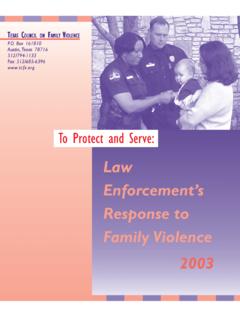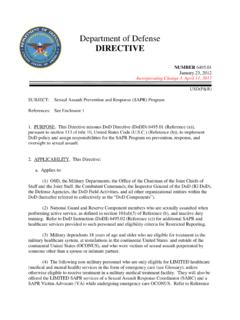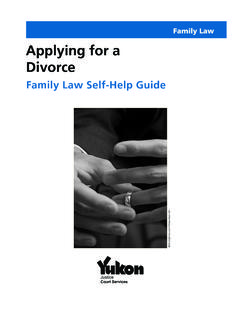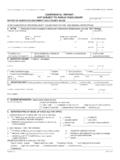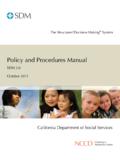Transcription of The Role of Law Enforcement in the Response to Child Abuse ...
1 The Role of Law Enforcement in the Response to Child Abuse and Neglect Donna Pence Charles Wilson 1992 Department of Health and Human Services Administration for Children and Families Administration on Children, Youth and Families National Center on Child Abuse and Neglect This manual was developed and produced by The Circle, Inc., McLean, VA, under Contract No. HHS-105-88-1702. This page is intentionally left blankADDITIONAL ACKNOWLEDGMENT The Department of Health and Human Services acknowledges the contribution of Diane D.
2 Broadhurst, author of The Role of Law Enforcement in the Prevention and Treatment of Child Abuse and Neglect, 1979. Ms. Broadhurst also authored the 1984 revision to this manual. TABLE OF CONTENTS Page PREFACE i ACKNOWLEDGMENTS iii INTRODUCTION 1 Purpose of Manual 1 OVERVIEW OF THE Child PROTECTION SYSTEM 3 ROLE OF LAW Enforcement IN COMBATING Child MALTREATMENT 5 Specialized Knowledge and Skills 5 Law Enforcement Roles 6 Prevention/Advocacy 6 Reporting 6 Support to Child Protective Services 6 Immediate Response 7 Investigative Role 7 Victim Support 7 The Team Investigation 8 Problems in Working Together 9 Systems Level Recommendations 10 Individual Level
3 Recommendations 11 THE INVESTIGATIVE PROCESS 13 Interviewing the Reporter 13 Gathering Information From the Reporter 13 Demographic Information 13 Information Regarding the Alleged Maltreatment 14 Information Regarding the Child 15 Information Regarding the Parent(s)/Caretaker(s) 15 Information About the Family 15 Field Interviews 16 Physical Neglect 16 Physical Abuse 17 Interviewing the Alleged Victim 17 Interviewing Caretaker(s) 18 Interviewing Other Children 18 Medical Examination 19 Crime Scene 19 Interviewing the Alleged Perpetrator 19 Sexual Abuse 19 Interviewing the Alleged Victim 20 Interviewing Other Children/Siblings 21 Interviewing Other Adult Witnesses 21 Interviewing the Nonoffending Spouse 21 Interviewing Parents in Out-of-Home Abuse Cases 24 Page Medical Examinations 24 Behavioral or Physical Indicators That Might be Indicators of Sexual Abuse Allegations in Divorce Proceedings Crime Scene Search 25
4 Interviewing the Alleged Perpetrator 29 Mental Health Information 31 DECISION MAKING 33 Validation 33 Physical Abuse and Neglect 33 Medical Evidence 33 Admission of the Perpetrator 33 Credible Witnesses 33 Mental Health Information 34 Victim s Statement 34 Observed, Videotaped, or Photographed Injuries or Conditions 34 Physical Evidence 34 Behavioral or Physical Indicators of Abuse 34 Sexual Abuse 34 Medical Findings 34 Admission of the Perpetrator 34 Credible Witnesses 35 Victim s Statement 35 Observed, Videotaped.
5 Or Photographed Injuries or Conditions 38 Physical Evidence 38 Childhood Trauma 38 Summary 38 Risk Assessment 38 Safety Planning 40 Removal From the Home 40 SPECIAL CONSIDERATIONS FOR INTERVIEWING CHILDREN 41 The Interview Process 41 Encouraging Children To Use Their Own Language 43 Establishing Details of the Assault 44 Interviewing Tools 46 Puppets 46 Drawings 46 Bodygrams or Anatomically Detailed Drawings 46 Doll Houses/Small Toy People 46 Prevention Materials 47 Dolls 47 Anatomically Detailed Dolls 47 SPECIAL TYPES OF INVESTIGATIONS 49 Cross-Cultural Investigations 49 or Related to Child Custody Disputes 49 Page Allegations of Sexual Abuse in Foster Care 50 Macro-Case 51 Investigative Teams and Design 52 Parents 55 Investigation of Child Deaths 56 Investigatory Steps 56 The Crime Scene 56 Interviewing Adults 56 Interviewing Other Children 57 Interviewing Professionals 57 Providing Relevant Information to Medical Examiner Prior to Autopsy 57 SPECIAL INVESTIGATIVE TECHNIQUES
6 59 Monitored Pretext Telephone or Personal Conversations 59 Telephone Method 59 Personal Conversation 59 Cautions 59 Investigative Risks 59 Polygraphs and Psychological Stress Evaluations 60 Audiotapes or Videotapes 60 Advantages 61 Disadvantages 61 ISSUES IN ARREST 63 The Miranda Warning 63 Use of Arrest Versus Grand Jury Presentation 63 CONCLUSION 65 GLOSSARY OF TERMS 67 NOTES 69 SELECTED BIBLIOGRAPHY 73 OTHER RESOURCES 77 PREFACE The Child Abuse Prevention and Treatment Act was signed into law in 1974.
7 Since that time, the Federal Government has served as a catalyst to mobilize society s social service, mental health, medical, education, legal, and law Enforcement resources to address the challenges in the prevention and treatment of Child Abuse and neglect. In 1977, in one of its early efforts, the National Center on Child Abuse and Neglect (NCCAN) developed 21 manuals (the User Manual Series) designed to provide guidance to professionals involved in the Child protection system and to enhance community collaboration and the quality of services provided to children and families.
8 Some manuals described professional roles and responsibilities in the prevention, identification, and treatment of Child maltreatment. Other manuals in the series addressed special topics, for example, adolescent Abuse and neglect. Our understanding of the complex problems of Child Abuse and neglect has increased dramatically since the user manuals were developed. This increased knowledge has improved our ability to intervene effectively in the lives of troubled families.
9 For example, it was not until the early 1980 s that sexual Abuse became a major focus in Child maltreatment research and treatment. Likewise, we have a better grasp of what we can do to prevent Child Abuse and neglect from occurring. Furthermore, our knowledge of the unique roles key professionals can play in Child protection has been defined more clearly, and a great deal has been learned about how to enhance coordination and collaboration of community agencies and professionals.
10 Currently, we are facing new and more serious problems in families who maltreat their children. For example, there is a significant percentage of families known to Child Protective Services (CPS) who are experiencing substance Abuse problems; the first drug-exposed infant appeared in the literature in 1985. Because our knowledge base has increased significantly and the state-of-the-art of practice has improved considerably, NCCAN has updated the User Manual Series by revising many of the existing manuals and creating new manuals that address current innovations, concerns, and issues in the prevention and treatment of Child maltreatment.










